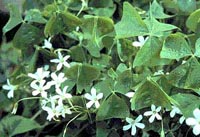Resource Library
Plant of the Week: Shamrock
The University of Arkansas System Division of Agriculture does not promote, support or recommend plants featured in "Plant of the Week." Please consult your local Extension office for plants suitable for your region.
Plant of the Week
Shamrock
Latin: Oxalis regnellii

As a kid growing up in what looks like a German-Protestant enclave in central Oklahoma, I never quite understood St. Patrick's day. Sure, I not only was pinched but managed to bestow a few pinches on those unlucky classmates failing to abide the "wearing of the green" rule. But still, the significance of the day escaped me.
That a religious holiday – what St. Patrick's day is at its heart, despite all the beer drinking and revelry – should have a plant associated with it is not surprising. That the plant sold as the "shamrock" is really from South America and not Ireland may take a bit of explanation.
Shamrock is a tender pot-plant that grows from an underground rhizome that looks like a zipper. The three lobed green leaves are borne aloft on slender petioles about 6 inches long. The individual leaflets are triangular.
The name shamrock is derived from the Celtic word for clover, which also has three leaflets. St. Patrick is said to have used the shamrock to illustrate the principle of the trinity to the people he converted. It's unclear if the shamrock St. Patrick used was the Irish clover, Trifolium repens, or the native wood sorrel, Oxalis acetosella.
The flowers of O. regnellii appear in greatest abundance in the spring and sporadically throughout the growing season. Flowers are an inch long, white, five-petaled trumpets borne in
a loose terminal cluster that tend to flop about. This species is native to Argentina, Bolivia and Paraguay, and it seems to have been cultivated in this country since the 1930's.
St. Patrick, born in Britain as Maewyn Succat in 387 AD and fathered by a Roman officer, was sent to Ireland in 432 as a missionary to convert the masses to Christianity. His most famous legend, that he drove the snakes from Ireland, is really a metaphor for driving the Druids, the shaman and magicians of the Celts from the Green Isle. He died in 461 on March 8 or March 9.
Because no agreement could be reached on which day he died, the holiday is celebrated on the 17th of March, the sum of 8 and 9. The first St. Patrick's day was celebrated in the U.S. in Boston in 1737. Thanks to the Irish potato famine of the 1840's, we have more people of Irish descent in the U.S. than in Ireland.
The use of O. regnellii is an American convention foisted upon the horticulturally uninitiated by the greenhouse industry. The plant is ideal for the holiday because it has the tripartite leaves, is green and is showy in a 6-inch pot. That the plant comes from the wrong continent is a bit of geographic formality that need not concern the average holiday celebrant.
The shamrock is easy to grow as a houseplant. Give it bright, indirect light. Allow the soil to dry slightly before rewatering. Fertilize with a houseplant fertilizer during the summer months and, if possible, relocate the plant to a shaded patio for a summer vacation out-of-doors. The foliage will usually die down late in the fall, at which time the pot should be allowed to dry down. Begin watering in early February to force the plant back into growth. Watch for spider mites, its most troublesome foe.
Snakes don't seem to bother it, so I guess it's magic still holds.
By: Gerald Klingaman, retired
Extension Horticulturist - Ornamentals
Extension News - March 16, 2001
The University of Arkansas System Division of Agriculture does not maintain lists of retail outlets where these plants can be purchased. Please check your local nursery or other retail outlets to ask about the availability of these plants for your growing area.